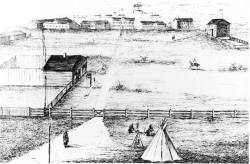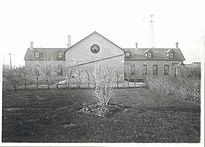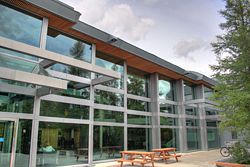
Northwest Territories Legislative Building
Encyclopedia
The Northwest Territories Legislative Building is the home of the Government of the Northwest Territories
. The most recent building was built in 1993 and commenced usage in 1994. The Government has used many permanent and temporary facilities throughout its history.
The current building is two stories tall with two round halls, the Great Hall and the Caucus Room. It is located in Yellowknife
, and overlooks Frame Lake. It was designed by Ferguson Simek Clark/Pin Matthews (of Yellowknife) in association with Matsuzaki Wright Architects Inc. (of Vancouver), and landscape architect Cornelia Oberlander
.
The House was originally built for the provisional government of Louis Riel
.
 The Northwest Territories government moved to Fort Livingstone
The Northwest Territories government moved to Fort Livingstone
in 1876. Legislative sessions were held inside the Swan River Barracks which operated and housed the North-West Mounted Police. The Barracks were built two years earlier in 1874, and destroyed by a wild fire long after the Government left in 1884. In addition to serving the Government, the Barracks served as living quarters for 185 men and their horses.
 The Territorial Government buildings in Regina, dating from 1883, consisted of the Legislative Building, the Administration Building and the Indian Office and were designed by the Dominion architect, Thomas Fuller
The Territorial Government buildings in Regina, dating from 1883, consisted of the Legislative Building, the Administration Building and the Indian Office and were designed by the Dominion architect, Thomas Fuller
. The mansard roofed Administration Building remains standing. After the North-West Territories Legislature was moved to Ottawa in 1905, the building housed the Legislative Assembly of Saskatchewan
until 1910. In 1922 the building was partially destroyed by fire; the Saskatchewan government repaired the building and leased it to the Salvation Army
until 1971. The building was fully restored and made a heritage site in 1979.
in Ottawa.

The new Legislative Assembly Building in Yellowknife was completed in 1993. It was the first building specifically built for the needs of the Assembly since the Territorial Administration Building in Regina. The new building was designed with themes from the local native populations that inhabit the territories and was designed for a 100 year-plus life span.
Sited directly on the lake shore, it is nestled between rock outcroppings of the Canadian Shield, a natural peat bog, and large stands of existing trees. Extensive use of natural materials was used throughout, including zinc panels, maple ceiling and panels, and slate floors. The exterior cladding is zinc, an economically significant material mined in the Territories. The curved roof edges provide a finished appearance for airplane passengers taking off/landing at the nearby main airport across the lake in addition to its airplane-wing shape helping to wind-scour snow from the roof to avoid ice and water damage.
The Great Hall has floor-to-ceiling windows facing directly into the treed forecourt allowing the natural slate floor appear to merge the inside with the outside. Special consideration was given to maximizing natural light to all of the main spaces and offices. Opening vent panels in each Members' office provides user-control of fresh air and an environment suited for people who may not be accustomed to spending days in an air-conditioned office building.
The Chamber and Caucus Room are circular to support the consensus-style government. Translation booths surround the Chamber for translators to provide simultaneous translation of the Terrirories' eleven official languages for all Members. Skylights ring the Chamber and Caucus Room as sunlight and daylight come from 360 degrees during the summer. The wall behind the Speaker is of hand-tooled zinc which mimics nearby rock formations. The stand in front of the Speaker's Chair is for the parliamentary mace which, in addition to indicating the authority of the Crown, incorporates ivory walrus tusks and wood from the ill-fated ships of the 1845 Franklin expedition.
Construction was undertaken using a fast-track method to meet critical construction and opening deadlines. Major construction materials needed to be brought north to Yellowknife, including by ferry in the summer and ice roads in the winter. During spring thaw and fall freeze-up neither was accessibile. The steel structure therefore had to be erected during the winter which meant almost no welding was possible and most connections had to be bolted.
Careful attention was given to preserving and restoring the landscape, which involved careful protection of existing trees which were only 10 feet from the exterior walls. Native plants were harvested and propagated in "The South", where growing seasons are longer, then returned to the site for restoration of the lakeshore and peat bog. The services annex for the building also has a planted roof which lessens the reduction in natural planted area by the building's footprint.
Northwest Territories
The Northwest Territories is a federal territory of Canada.Located in northern Canada, the territory borders Canada's two other territories, Yukon to the west and Nunavut to the east, and three provinces: British Columbia to the southwest, and Alberta and Saskatchewan to the south...
. The most recent building was built in 1993 and commenced usage in 1994. The Government has used many permanent and temporary facilities throughout its history.
The current building is two stories tall with two round halls, the Great Hall and the Caucus Room. It is located in Yellowknife
Yellowknife, Northwest Territories
Yellowknife is the capital and largest city of the Northwest Territories , Canada. It is located on the northern shore of Great Slave Lake, approximately south of the Arctic Circle, on the west side of Yellowknife Bay near the outlet of the Yellowknife River...
, and overlooks Frame Lake. It was designed by Ferguson Simek Clark/Pin Matthews (of Yellowknife) in association with Matsuzaki Wright Architects Inc. (of Vancouver), and landscape architect Cornelia Oberlander
Cornelia Oberlander
Cornelia Hahn Oberlander, OC is a Canadian landscape architect based in Vancouver, British Columbia. During her career she has contributed to the designs of many high-profile buildings in both Canada and the United States, including the Robson Square and Law Courts Complex in Vancouver, the...
.
Early Government House
The North-West Council was first housed in the Early Government House building in Fort Garry. The building was the official residents of the Manitoba Lieutenant Governor. The building was used until 1883 when the Lieutenant Governor moved into newer quarters.The House was originally built for the provisional government of Louis Riel
Louis Riel
Louis David Riel was a Canadian politician, a founder of the province of Manitoba, and a political and spiritual leader of the Métis people of the Canadian prairies. He led two resistance movements against the Canadian government and its first post-Confederation Prime Minister, Sir John A....
.
Swan River Barracks

Fort Livingstone, Saskatchewan
Fort Livingstone was founded as an outpost in Northwest Territories, Canada.The outpost briefly served as the capital city for North-West Territories government for the years of 1874 to 1876, and headquarters for the North-West Mounted Police for the same period, until they moved headquarters to...
in 1876. Legislative sessions were held inside the Swan River Barracks which operated and housed the North-West Mounted Police. The Barracks were built two years earlier in 1874, and destroyed by a wild fire long after the Government left in 1884. In addition to serving the Government, the Barracks served as living quarters for 185 men and their horses.
NWT Government House Battleford
The NWT Government House in Battleford was the first building designed for the Northwest Territories Legislative Assembly. It was used for sessions from 1877 to 1883. The building also served as residence for the Lieutenant Governor who had to preside over Assembly sessions and the Executive council. The building was destroyed by fire in 2003.Territorial Administration Building, Regina, Assiniboia, North-West [sic] Territories

Thomas Fuller (architect)
Thomas Fuller was a Canadian architect.He was born in Bath, Somerset , where he trained as an architect. Living in Bath and London he did a number of projects. In 1845 he left for Antigua, where he spent two years working on a new cathedral before emigrating to Canada in 1857...
. The mansard roofed Administration Building remains standing. After the North-West Territories Legislature was moved to Ottawa in 1905, the building housed the Legislative Assembly of Saskatchewan
Legislative Assembly of Saskatchewan
The 25th Legislative Assembly of Saskatchewan was in power from 2003 until November 20, 2007. It was controlled by the Saskatchewan New Democratic Party under premier Lorne Calvert.-Members:-By-elections:...
until 1910. In 1922 the building was partially destroyed by fire; the Saskatchewan government repaired the building and leased it to the Salvation Army
Salvation Army
The Salvation Army is a Protestant Christian church known for its thrift stores and charity work. It is an international movement that currently works in over a hundred countries....
until 1971. The building was fully restored and made a heritage site in 1979.
Sparks Street
After the Legislative Assembly was dissolved in 1905 the government was run out of an office building on Sparks StreetSparks Street
Sparks Street is a street in downtown Ottawa, Canada that was converted into an outdoor pedestrian street in 1966, making it the earliest such street or mall in North America....
in Ottawa.
Yellowknife Legislature

The new Legislative Assembly Building in Yellowknife was completed in 1993. It was the first building specifically built for the needs of the Assembly since the Territorial Administration Building in Regina. The new building was designed with themes from the local native populations that inhabit the territories and was designed for a 100 year-plus life span.
Sited directly on the lake shore, it is nestled between rock outcroppings of the Canadian Shield, a natural peat bog, and large stands of existing trees. Extensive use of natural materials was used throughout, including zinc panels, maple ceiling and panels, and slate floors. The exterior cladding is zinc, an economically significant material mined in the Territories. The curved roof edges provide a finished appearance for airplane passengers taking off/landing at the nearby main airport across the lake in addition to its airplane-wing shape helping to wind-scour snow from the roof to avoid ice and water damage.
The Great Hall has floor-to-ceiling windows facing directly into the treed forecourt allowing the natural slate floor appear to merge the inside with the outside. Special consideration was given to maximizing natural light to all of the main spaces and offices. Opening vent panels in each Members' office provides user-control of fresh air and an environment suited for people who may not be accustomed to spending days in an air-conditioned office building.
The Chamber and Caucus Room are circular to support the consensus-style government. Translation booths surround the Chamber for translators to provide simultaneous translation of the Terrirories' eleven official languages for all Members. Skylights ring the Chamber and Caucus Room as sunlight and daylight come from 360 degrees during the summer. The wall behind the Speaker is of hand-tooled zinc which mimics nearby rock formations. The stand in front of the Speaker's Chair is for the parliamentary mace which, in addition to indicating the authority of the Crown, incorporates ivory walrus tusks and wood from the ill-fated ships of the 1845 Franklin expedition.
Construction was undertaken using a fast-track method to meet critical construction and opening deadlines. Major construction materials needed to be brought north to Yellowknife, including by ferry in the summer and ice roads in the winter. During spring thaw and fall freeze-up neither was accessibile. The steel structure therefore had to be erected during the winter which meant almost no welding was possible and most connections had to be bolted.
Careful attention was given to preserving and restoring the landscape, which involved careful protection of existing trees which were only 10 feet from the exterior walls. Native plants were harvested and propagated in "The South", where growing seasons are longer, then returned to the site for restoration of the lakeshore and peat bog. The services annex for the building also has a planted roof which lessens the reduction in natural planted area by the building's footprint.

